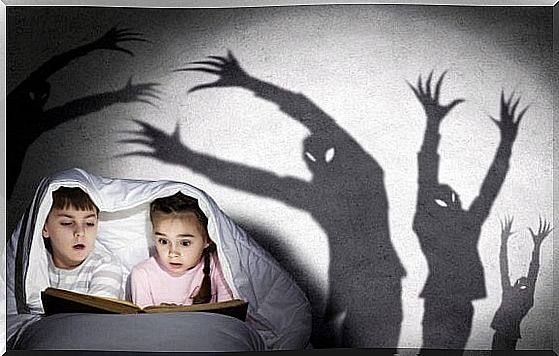How To Tell Horror Stories To Children

How to tell horror stories to children is a common question among mothers. It is normal to want to protect children from fear, risky situations or bad news. However, that shouldn’t stop you from reading horror stories or talking to children about the sad realities of the world.
It is very important that you help the child to understand, ask the necessary questions, face their fears and overcome them.
Children are very impressionable and also fearful. Therefore, it is very important to harness their ability to imagine to help overcome their fears.
When telling them a story, activate their knowledge and, therefore, their creativity. If you want to hold the children’s attention, you need to live the story with them so they can overcome their fear.
Educators, psychologists and teachers not only recommend horror stories as a form of entertainment, but also because they are important lessons in child development.
Below you will find recommendations on how to tell horror stories to children and the main reasons why they teach something.
Why is it important for children to read scary stories?
Depending on the age of children, they will naturally be afraid of many things. It may be that at some point they are afraid of not being loved, or of being less loved than their siblings.
This will cause fear of losing the parents or of them separating. In addition, they may also be afraid of death and many other things that you are certainly not even aware of.

As much as children talk a lot with their parents, maybe there are some secret fears they don’t share. There are also children who have unconscious fears.
For this reason, we recommend that children read or that you read them scary stories. In this way they can question feelings and express emotions, as well as learn to face fears or, at least, know how to control them.
When little ones read this kind of story, they unconsciously project the positive qualities onto the hero or heroine of the story, while the negative is attributed to the villain, monster or witch.
How to tell horror stories to children under 6 years old?
If you want to learn how to tell horror stories to children under 6, keep in mind that they both love and fear the unknown. Generally they also like the tales of witches and monsters, although they are not so scary.
This kind of story helps children understand that fear shouldn’t paralyze. Furthermore, they learn that without fear they will be more open to learn, relate and share better, to discover and love unconditionally.
You can follow these tips if you want to tell scary stories to your kids under 6:
- Choose stories of witches, vampires, ghosts and themes that scare them enough. Remember to make an evil voice and play the monsters or ghosts in the story well. Don’t forget that humor trumps fear, so you can make jokes as you tell the story.
- Pay attention to the questions and fears children have when listening to the story. Answer your questions and, if necessary, adapt the story according to your reactions.
- Remember that little ones should be tense but not scared. Try to narrate the most frightening moments in the story in a leisurely tone, slowly and without changing your voice.
How to tell horror stories to children between 7 and 11 years old?
If you want to learn how to tell scary stories to children between 7 and 11 years old, remember that at this stage they are very impressionable. Therefore, we recommend that you follow these tips:
- Tell the horror story by mixing scary parts with funny parts. You can also add unexpected and unusual ringtones. This will make the little ones laugh, release tension and relax, thus helping to deal with fear.

- Also, you can play with your voice to set the story. Imitate the noises, make a witch’s voice, speak in a deeper tone to play the evil characters, stop for a few seconds to add to the mystery…
- Another suggestion is to decorate the child’s room by dimming the light or using a lamp or candle. Remember that, as with younger children, humor trumps fear. Try to alleviate tension and fear by incorporating jokes into the narrative.
- Finally, we recommend using other elements to further set the story. The most important thing when choosing a horror story for kids is knowing the recommended age and making sure that good outweighs evil. Remember that when you talk to children about fear, you help them prepare for life.









